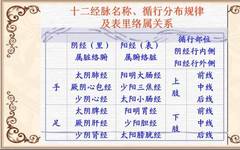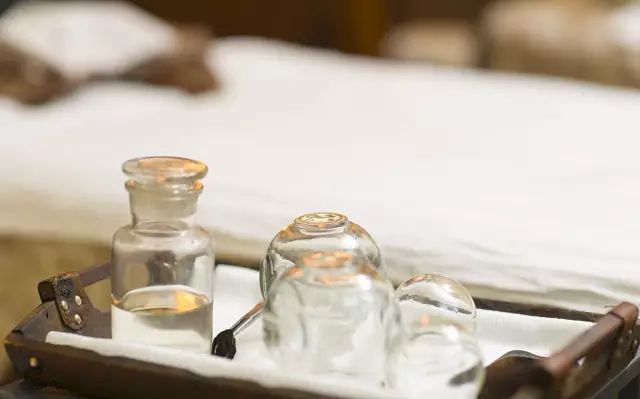
Three Yin Meridians of the Hand: Taiyin Lung Meridian (Shǒu Tàiyīn Fèi Jīng), Jueyin Pericardium Meridian (Shǒu Juéyīn Xīnbāo Jīng), Shaoyin Heart Meridian (Shǒu Shàoyīn Xīn Jīng)
Three Yang Meridians of the Hand: Yangming Large Intestine Meridian (Shǒu Yángmíng Dàcháng Jīng), Shaoyang Sanjiao Meridian (Shǒu Shàoyáng Sān Jiāo Jīng), Taiyang Small Intestine Meridian (Shǒu Tàiyáng Xiǎocháng Jīng)
Three Yang Meridians of the Foot: Yangming Stomach Meridian (Zú Yángmíng Wèi Jīng), Shaoyang Gallbladder Meridian (Zú Shàoyáng Dǎn Jīng), Taiyang Bladder Meridian (Zú Tàiyáng Pángguāng Jīng)
Three Yin Meridians of the Foot: Taiyin Spleen Meridian (Zú Tàiyīn Pí Jīng), Jueyin Liver Meridian (Zú Juéyīn Gān Jīng), Shaoyin Kidney Meridian (Zú Shàoyīn Shèn Jīng)
Pathways: The Three Yin Meridians of the Hand run from the chest to the hand; the Three Yang Meridians of the Hand run from the hand to the head; the Three Yang Meridians of the Foot run from the head to the foot; the Three Yin Meridians of the Foot run from the foot to the abdomen.
“In all needling, one must connect to the beginning and end of the twelve meridians.”
Interrelationship of the Twelve Meridians
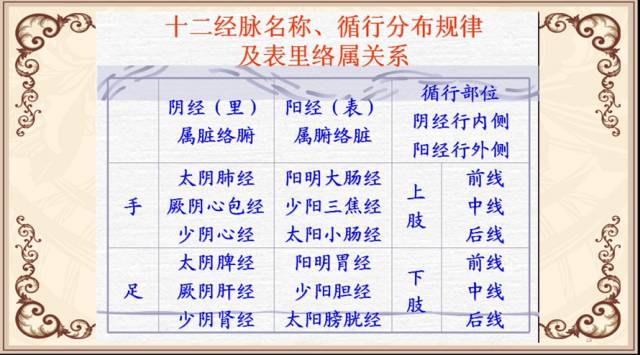
Song of the Connection Sequence of the Twelve Meridians
At the hour of the Tiger, Qi and blood flow to the Lung
At the hour of the Rabbit, the Large Intestine; at the hour of the Dragon, the Stomach
At the hour of the Snake, the Spleen; at the hour of the Horse, the Heart; at the hour of the Goat, the Small Intestine
At the hour of the Monkey, it belongs to the Bladder; at the hour of the Rooster, the Kidney
At the hour of the Dog, the Pericardium; at the hour of the Pig, the Sanjiao
At the hour of the Rat, the Gallbladder; at the hour of the Ox, the Liver
Table of Source, Luo, and Transport Points of the Twelve Meridians (Key Points)
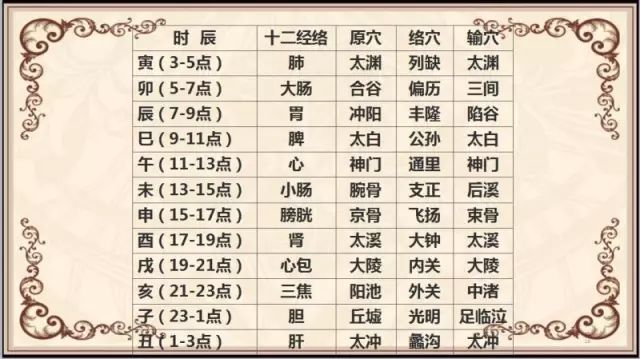
Locations of the Twelve Meridians and Their Source, Luo, and Transport Points
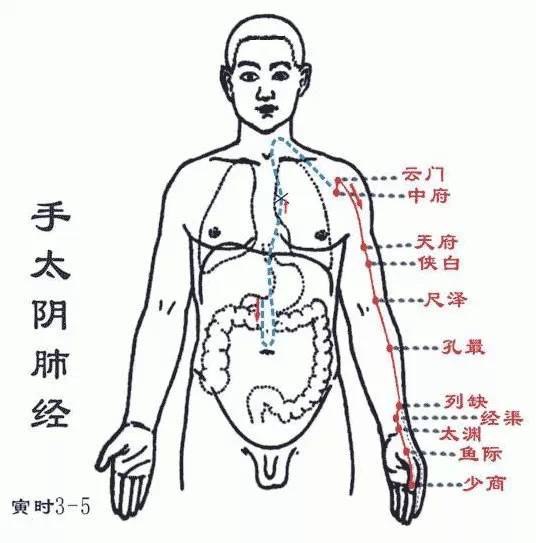
Taiyin Lung Meridian (Shǒu Tàiyīn Fèi Jīng) (Hour of the Tiger: 3-5 AM): From the chest to the hand
Originates in the middle jiao (stomach area), connects downward to the Large Intestine, returns along the stomach’s upper opening, passes through the diaphragm, and belongs to the Lung. From the lung system—trachea, throat—crosses out under the armpit (Zhōngfǔ, Yúnmén), descends along the inner side of the upper arm, runs to the hand Shaoyin, before the hand Jueyin (Tiānfǔ, Xiábái), descends to the elbow (Chǐzé), along the inner side of the forearm along the radius (Kǒngzuì), enters the wrist (Cùn Kǒu)—the radial artery pulse point (Jīngqú, Tàiyuán), ascends to the thenar area, along the margin (Yújì), exits at the tip of the thumb (Shàoshāng).
Branch: From the back of the wrist (Lièxuè) runs to the inner side of the index finger (Ráo), exits at its tip, connecting with the Yangming Large Intestine Meridian.
This meridian has 11 points on one side (22 points total), with 9 points distributed on the radial side of the upper limb’s palm surface, 2 points in the upper part of the chest, starting point Zhōngfǔ, endpoint Shàoshāng.
Indications: Respiratory system disorders and conditions in areas traversed by this meridian.
● Points of this meridian: Zhōngfǔ, Yúnmén, Tiānfǔ, Xiábái, Chǐzé, Kǒngzuì, Lièxuè, Jīngqú, Tàiyuán, Yújì, Shàoshāng.
● Source point: Tàiyuán (at the radial side of the wrist crease, in the depression on the radial side of the radial artery)
● Luo point: Lièxuè (1.5 cun above the wrist crease, on the radial side of the forearm)
● Transport point: Tàiyuán (at the radial side of the wrist crease, in the depression on the radial side of the radial artery)
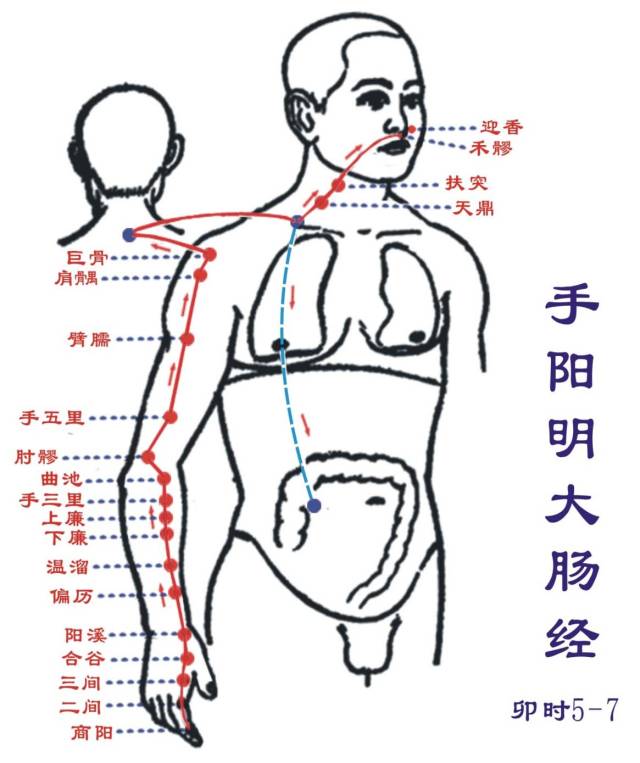
Yangming Large Intestine Meridian (Shǒu Yángmíng Dàcháng Jīng) (Hour of the Rabbit: 5-7 AM): From the hand to the head
Starts at the tip of the index finger (Shāngyáng), runs along the radial side of the index finger (Èrjiān, Sānjiān), exits between the first and second metacarpals (Hégǔ), enters between the two tendons (the long and short extensor tendons of the thumb) (Yángxī), along the radial side of the forearm (Piānlì, Wēnliú, Xiàlián, Shànglián, Shǒusānli), enters the outer side of the elbow (Qūchí, Zhǒuliáo), along the outer side of the upper arm (Shǒuwǔlǐ, Bìngnà), ascends to the shoulder, exits at the front of the acromion (Jiānyú, Jùgǔ, Huìbǐngfēng), meets at the neck (Huìdàzhuī), descends into the supraclavicular fossa, connects to the Lung, passes through the diaphragm, and belongs to the Large Intestine.
The Yangming Large Intestine Meridian is closely related to the Lung Meridian. When there are diseases in the respiratory system, the Qūchí point on the Large Intestine Meridian is often used as a treatment point. Abnormalities in the Large Intestine Meridian can lead to symptoms such as toothache, nasal congestion, dry mouth, and throat swelling. If pressure is applied to the shoulder area down to the arm, pain may also occur.
This meridian has 20 points on one side (40 points total), with 15 points distributed on the radial side of the upper limb’s dorsal surface, and 5 points in the neck and face. Starting point Shāngyáng, endpoint Yíngxiāng.
Indications include diseases of the stomach, intestines, and other abdominal conditions, neurological and psychiatric disorders, certain febrile diseases, and conditions of the eyes, ears, mouth, teeth, nose, throat, and areas traversed by this meridian.
● Points of this meridian: Shāngyáng, Èrjiān, Sānjiān, Hégǔ, Yángxī, Piānlì, Wēnliú, Xiàlián, Shànglián, Shǒusānli, Qūchí, Zhǒuliáo, Shǒuwǔlǐ, Bìngnà, Jiānyú, Jùgǔ, Tiāndǐng, Fútú, Kǒuhéliáo, Yíngxiāng.
● Source point: Hégǔ (on the back of the hand, between the first and second metacarpals, at the midpoint of the radial side of the second metacarpal)
● Luo point: Piānlì (on the back of the elbow, 3 cun above the wrist crease)
● Transport point: Sānjiān (when making a fist, in the depression on the radial side of the second metacarpal head)
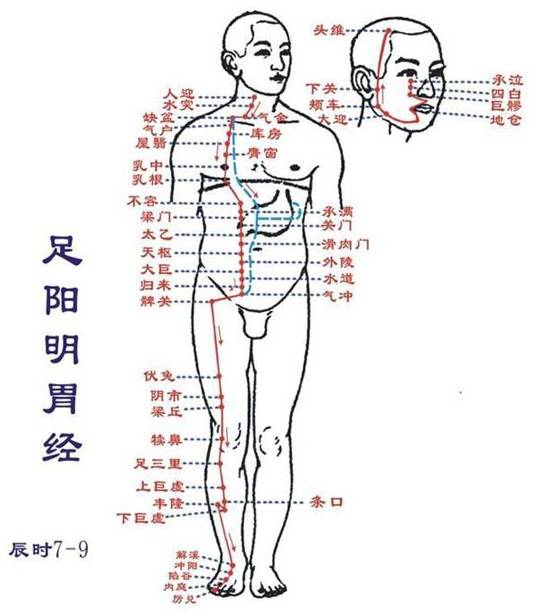
Yangming Stomach Meridian (Zú Yángmíng Wèi Jīng) (Hour of the Dragon: 7-9 AM): From the head to the foot
Starts beside the nose (Huìyíngxiāng), meets at the root of the nose, alongside the Taiyang Meridian (Huìjīngmíng), descends along the outer side of the nose (Chéngqì, Sìbái), enters the upper dental arch (Jùliáo), returns to the area beside the mouth (Dìcāng), encircles the lips (Huìrénzhōng), descends to meet at the mentolabial groove (Huìchéngjiāng); returns along the lower jaw to the facial artery area (Dàyíng), then along the jaw angle (Jiáochē), ascends in front of the ear (Xiàguān), along the zygomatic arch (Shàngguān, Xuánlì, Huàn yàn), along the hairline (Tóuwéi), to the center of the forehead (Huìshéntíng).
Its branch: from the front of Dàyíng downwards, through the carotid area (Rén yíng), along the throat (Shuǐtū, Qìshè, one says Huìdàzhuī), enters the supraclavicular fossa (Shàngguān), passes through the diaphragm, belongs to the Stomach (Shàngwǎn, Zhōngwǎn), connects to the Spleen.
Its branch: from the Stomach, descends along the abdomen, to the groin area, meeting the previous branch. From here, it descends through the front of the hip joint (Bǐguān), to the quadriceps muscle (Fútù, Yīnshì, Liángqiū), descends to the knee (Dùbǐ), along the outer side of the tibia (Zú Sānli, Shàngjùxū, Tiáokǒu, Xiàjùxū), descends to the dorsum of the foot (Jiěxī, Chōngyáng), enters the inner side of the second toe (Xiànggǔ, Nèitíng), exits at the tip of the second toe (Lìduì).
Its branch: from 3 cun below the knee (Zú Sānli) branches off (Fēnglóng), descends to the outer side of the second toe, exits at the tip of the second toe. Another branch: from the dorsum of the foot (Chōngyáng) branches off, enters the first toe’s interspace, exits at the tip of the first toe, connecting to the Taiyin Spleen Meridian.
This meridian has 45 points on one side (90 points total), with 15 points distributed on the anterior lateral side of the lower limb, 30 points in the abdomen, chest, and head and face. Starting point Chéngqì, endpoint Lìduì.
Indications include digestive system disorders, neurological system disorders, respiratory system disorders, circulatory system disorders, and conditions of the throat, head, face, mouth, teeth, nose, and areas traversed by this meridian.
● Source point: Chōngyáng (on the dorsum of the foot, at the base of the second metatarsal and the intermediate cuneiform joint, can feel the dorsalis pedis artery)
● Luo point: Fēnglóng (on the anterior lateral side of the lower leg, 8 cun above the tip of the lateral malleolus, at the horizontal finger distance from the anterior edge of the tibia)
● Transport point: Xiànggǔ (in the depression behind the second and third metatarsophalangeal joints on the dorsum of the foot)
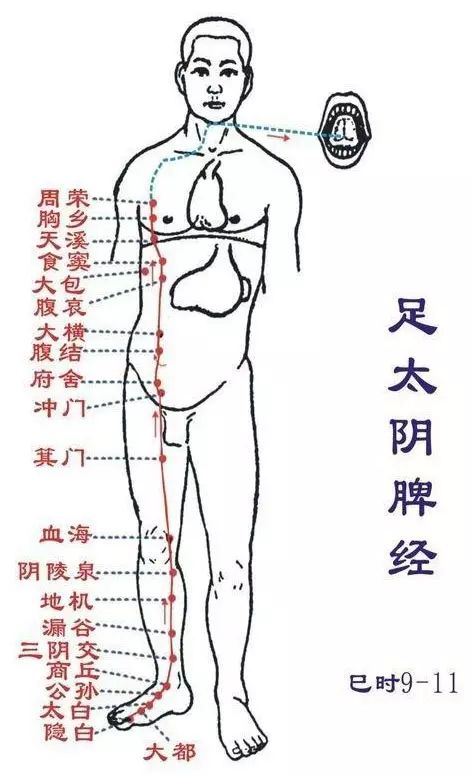
Taiyin Spleen Meridian (Zú Tàiyīn Pí Jīng) (Hour of the Snake: 9-11 AM): From the foot to the abdomen
Starts at the tip of the big toe (Yǐnbái), runs along the inner side of the big toe (Dàdū), passes through the first metatarsal head (Tàibái, Gōngsūn), ascends to the front of the inner malleolus (Shāngqiū), ascends along the inner side of the lower leg, along the posterior side of the tibia (Sānyīnjiāo, Lòugǔ), connects to the front of the knee (Xuèhǎi, Jīmén), enters the abdomen (Chōngmén, Fùshè, Fùjié, Dàhuàn; Zhōngjí, Guānyuán, belongs to the Spleen, connects to the Stomach (Fù’āi; Huìxiàwǎn, Rìyuè, Qīmén), passes through the diaphragm, alongside the esophagus (Shídòu, Tiānxī, Xiōngxiāng, Zhōuróng; connects to Dàbāo; meets at Zhōngfǔ), connects to the root of the tongue, disperses under the tongue.
Its branch: from the Stomach, ascends through the diaphragm, flows into the heart, connecting to the Hand Shaoyin Heart Meridian.
This meridian has 21 points on one side (42 points total), with 11 points distributed on the anterior side of the inner surface of the lower limb, and 10 points distributed on the lateral chest and abdomen. Starting point Yǐnbái, endpoint Dàbāo.
● Points of this meridian: Yǐnbái, Dàdū, Tàibái, Gōngsūn, Shāngqiū, Sānyīnjiāo, Lòugǔ, Dìjī, Yīnlíngquán, Xuèhǎi, Jīmén, Chōngmén, Fùshè, Fùjié, Dàhuàn, Fù’āi, Shídòu, Tiānxī, Xiōngxiāng, Zhōuróng, Dàbāo.
● Source point: Tàibái (behind the first metatarsal head, at the red-white junction)
● Luo point: Gōngsūn (in front of the first metatarsal base)
● Transport point: Tàibái (behind the first metatarsal head, at the red-white junction)
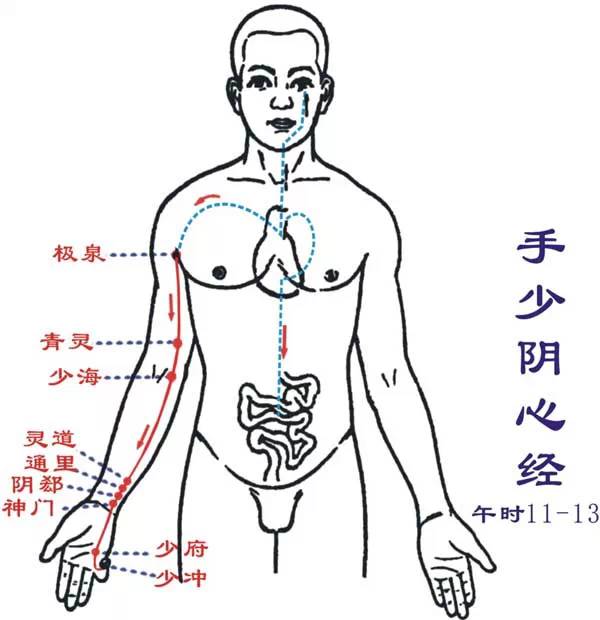
Shaoyin Heart Meridian (Shǒu Shàoyīn Xīn Jīng) (Hour of the Horse: 11 AM-1 PM): From the chest to the hand
Starts from the heart, emerges belonging to the heart and its connected organs, descends through the diaphragm, connects to the Small Intestine.
Its branch: from the heart’s connecting part ascends to the throat, linking to the eye’s connection to the brain.
Its direct pathway ascends from the heart system (the connection between the heart and its organs) to the Lung, descends out of the lower abdomen (Jíquán), along the inner side of the upper arm, runs to the Hand Taiyin, after the Hand Jueyin (Qīnglíng), descends to the inner elbow (Shàohǎi), along the inner side of the forearm (Língdào, Tōnglǐ, Yīnxuè, Shénmén), enters the palm at the pea bone area, exits at the tip of the little finger (Shàochōng), connecting to the Hand Taiyang Small Intestine Meridian.
This meridian has 9 points on one side (18 points total), with 8 points distributed on the ulnar side of the upper limb’s palm surface, and 1 point in the upper part of the chest. Starting point Jíquán, endpoint Shàochōng.
Indications include conditions of the chest, heart, circulatory system, neurological and psychiatric disorders, and conditions in areas traversed by this meridian.
● Points of this meridian: Jíquán, Qīnglíng, Shàohǎi, Língdào, Tōnglǐ, Yīnxuè, Shénmén, Shàofǔ, Shàochōng.
● Source point: Shénmén (at the radial side of the wrist crease)
● Luo point: Tōnglǐ (on the palm side of the forearm, on the radial side, 1 cun above the wrist crease)
● Transport point: Shénmén (at the radial side of the wrist crease)
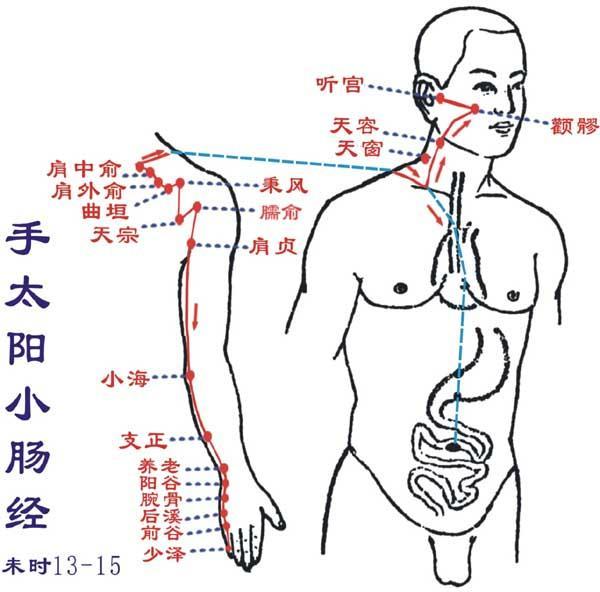
Taiyang Small Intestine Meridian (Shǒu Tàiyáng Xiǎocháng Jīng) (Hour of the Goat: 1-3 PM): From the hand to the head
Starts at the outer side of the little finger (Shàozé), runs along the ulnar side of the palm (Qián gǔ, Hòuxī), ascends to the wrist (Wàngǔ, Yánggǔ), exits at the ulnar head (Yǎnglǎo), directly ascends along the lower edge of the ulna (Zhīzhèng), exits at the inner side of the elbow between the humerus and the ulnar olecranon (Xiǎohǎi), ascends along the outer back of the upper arm, exits at the shoulder joint (Jiānzhēn, Nàoyǔ), encircles the scapula (Tiānzōng, Bǐngfēng, Qūyuán), meets at the shoulder (Jiānwàiyú, Jiānzhōngyú; Huìfùfēn, Dàzhù, Dàzhuī), enters the supraclavicular fossa, connects to the heart, along the esophagus, passes through the diaphragm, to the stomach (Shàngwǎn, Zhōngwǎn), belongs to the Small Intestine.
Its branch: from the supraclavicular fossa ascends along the neck (Tiānchuāng, Tiānróng), ascends to the cheek (Quánliáo), to the outer corner of the eye (Huìtóngzǐliáo), bends backward (Huìhéliáo), enters the ear (Tīnggōng). Another branch: from the cheek, ascends to the zygomatic bone, near the nose to the inner corner of the eye (Huìjīngmíng), connecting to the Taiyang Bladder Meridian. Additionally, the Small Intestine connects with the Yangming Stomach Meridian at the Xiàjùxū point.
This meridian has 19 points on one side (38 points total), with 8 points distributed on the ulnar side of the upper limb’s dorsal surface, and 11 points in the shoulder, neck, and face. Starting point Shàozé, endpoint Tīnggōng.
Indications include abdominal Small Intestine and chest, heart, throat conditions, certain febrile diseases, neurological disorders, and conditions in areas traversed by this meridian.
● Points of this meridian: Shàozé, Qián gǔ, Hòuxī, Wàngǔ, Yánggǔ, Yǎnglǎo, Zhīzhèng, Xiǎohǎi, Jiānzhēn, Nàoyǔ, Tiānzōng, Bǐngfēng, Qūyuán, Jiānwàiyú, Jiānzhōngyú, Tiānchuāng, Tiānróng, Quánliáo, Tīnggōng.
● Source point: Wàngǔ (on the palm side, at the radial side of the fifth metacarpal base)
● Luo point: Zhīzhèng (on the back of the forearm, 5 cun above the wrist crease)
● Transport point: Hòuxī (when making a fist, at the back of the fifth metacarpophalangeal joint)
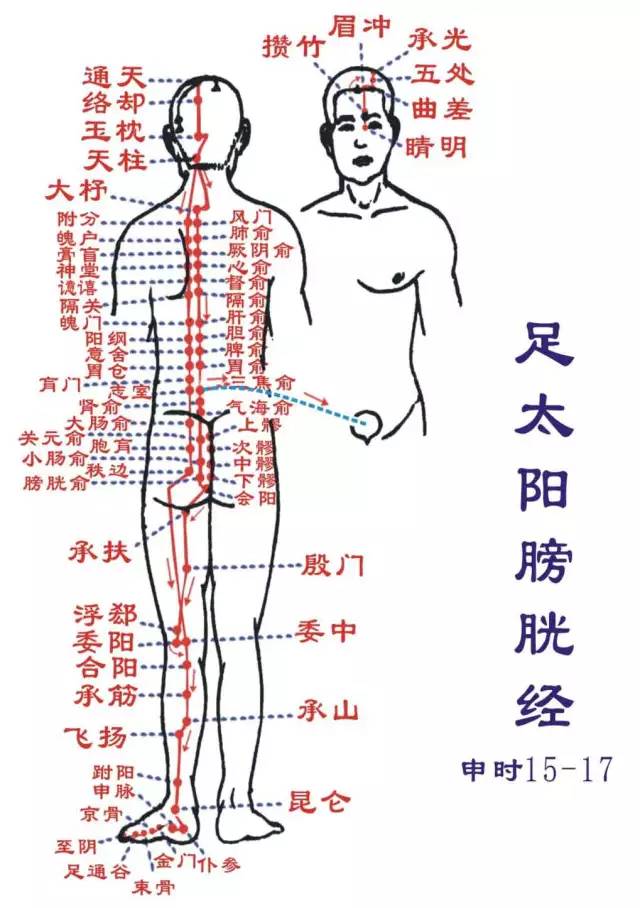
Taiyang Bladder Meridian (Zú Tàiyáng Pángguāng Jīng) (Hour of the Monkey: 3-5 PM): From the head to the foot
Starts at the inner corner of the eye (Jīngmíng), ascends to the forehead (Zhuānbó, Méichōng, Qūchā; Huìshéntíng, Tóulínqì), meets at the top of the head (Wǔchù, Chéngguāng, Tōngtiān; Huìbǎihuì).
Its branch: from the top of the head, descends to the ear (Huìqūbǐ, Shuàigǔ, Fúbái, Tóuqiàoyīn, Wángǔ).
Its direct pathway: from the top of the head enters the brain (Luòquè, Yùzhěn; Huìnǎohù, Fēngfǔ), exits at the nape (Tiānzhù) and descends:
One branch descends along the inner side of the shoulder blade, alongside the spine (Huìdàzhuī, Tàodào; Jīngdàzhù, Fēngmén, Fèi yú, Juéyīn yú, Xīnyú, Dū yú, Gè yú), reaches the waist (Gān yú, Dǎn yú, Pí yú, Wèi yú, Sān jiāo yú, Shèn yú), enters the muscles beside the spine, connects to the Kidney, belongs to the Bladder (Qìhǎi yú, Dàcháng yú, Guānyuán yú, Xiǎocháng yú, Pángguāng yú, Zhōnglǚ yú, Bái huán yú).
Another branch descends from the waist, alongside the spine, through the arm (Shàngyáo, Cìyáo, Zhōngyáo, Xiàyáo, Huìyáng, Chéngfú), enters the hollow (Yīnmén, Wěizhōng).
Another branch descends from the inner side of the shoulder blade, descends through the shoulder blade (Fùfēn, Pòhù, Gāohuāng yú, Shéntáng, Gèguān, Yìshè, Wèicāng, Zhìshì, Bāoháng, Zhìbiān), descends through the hip joint (Huìhuán tiāo), along the back of the thigh (Fúxiè, Wěiyáng), meets at the hollow (Wěizhōng)—from here descends through the gastrocnemius (Héyáng, Chéngjīn, Chéngshān), exits behind the lateral malleolus (Fēiyáng, Zǐyáng, Kūnlún), along the fifth metatarsal tuberosity (Pǔshēn, Shēnmài, Jīngmén, Jīnggǔ), to the outer side of the little toe (Shùgǔ, Zútōnggǔ, Zhìyīn), connecting to the Foot Shaoyin Kidney Meridian.
This meridian has 67 points on one side (134 points total), with 49 points distributed on the head, face, neck, and back, and 18 points distributed on the midline of the lower limb and the outer side of the foot. Starting point Jīngmíng, endpoint Zhìyīn.
Indications include urinary and reproductive system disorders, neurological and psychiatric disorders, respiratory system disorders, circulatory system disorders, digestive system disorders, and febrile diseases, as well as conditions in areas traversed by this meridian.
● Source point: Jīnggǔ (on the outer side of the foot, below the fifth metatarsal tuberosity, at the red-white junction)
● Luo point: Fēiyáng (on the posterior lateral side of the lower leg, 7 cun above the tip of the lateral malleolus)
● Transport point: Shùgǔ (below the fifth metatarsal head, at the red-white junction)
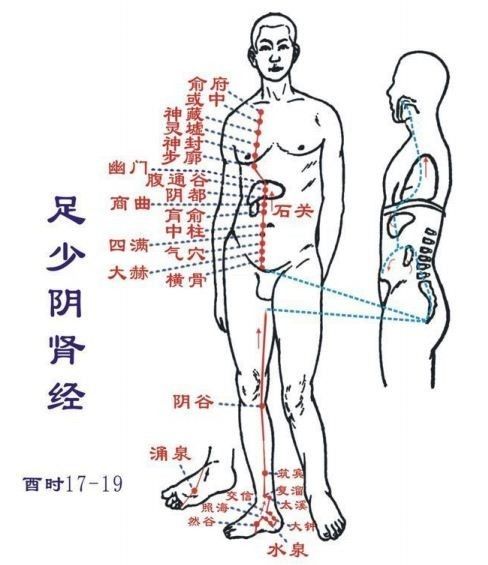
Shaoyin Kidney Meridian (Zú Shàoyīn Shèn Jīng) (Hour of the Rooster: 5-7 PM): From the foot to the abdomen
Starts from the bottom of the little toe, diagonally towards the center of the foot (Yǒngquán), exits below the navicular tuberosity (Rángǔ, Zhàohǎi, Shuǐquán), along the posterior side of the inner malleolus (Tàixī), branches into the heel (Dàzhōng); ascends along the inner side of the lower leg (Fùliú, Jiāoxìn; meets at Sānyīnjiāo), exits at the inner side of the hollow (Zhùbīn, Yīngǔ), ascends along the inner side of the thigh, through the spine (Huìchángqiáng), belongs to the Kidney, connects to the Bladder (Huāngyú, Zhōngzhù, Sìmǎn, Qìxué, Dàhè, Huìguānyuán, Zhōngjí).
Its direct pathway: from the Kidney ascends (Shāngqū, Shígū, Yīndū, Tōnggǔ, Yōumén), through the Liver, diaphragm, enters the Lung (Bùláng, Shénfēng, Língxū, Shéncáng, Yǔzhōng, Yúfǔ), along the throat, alongside the root of the tongue (Tōngliánquán).
Its branch: from the Lung, connects to the heart, flows into the chest, connecting to the Hand Jueyin Pericardium Meridian.
This meridian has 27 points on one side (54 points total), with 10 points distributed on the inner side of the lower limb, and 17 points in the chest and abdomen. Starting point Yǒngquán, endpoint Yúfǔ.
Indications include urinary and reproductive system disorders, neurological and psychiatric disorders, respiratory system disorders, digestive system disorders, and circulatory system disorders, as well as conditions in areas traversed by this meridian.
● Points of this meridian: Yǒngquán, Rángǔ, Tàixī, Dàzhōng, Shuǐquán, Zhàohǎi, Fùliú, Jiāoxìn, Zhùbīn, Yīngǔ, Huāngyú, Zhōngzhù, Sìmǎn, Qìxué, Dàhè, Huìguānyuán, Zhōngjí.
● Source point: Tàixī (in the depression between the inner malleolus and the Achilles tendon, at the level of the highest point of the inner malleolus)
● Luo point: Dàzhōng (on the inner side of the foot, below the Achilles tendon attachment)
● Transport point: Tàixī (in the depression between the inner malleolus and the Achilles tendon, at the level of the highest point of the inner malleolus)
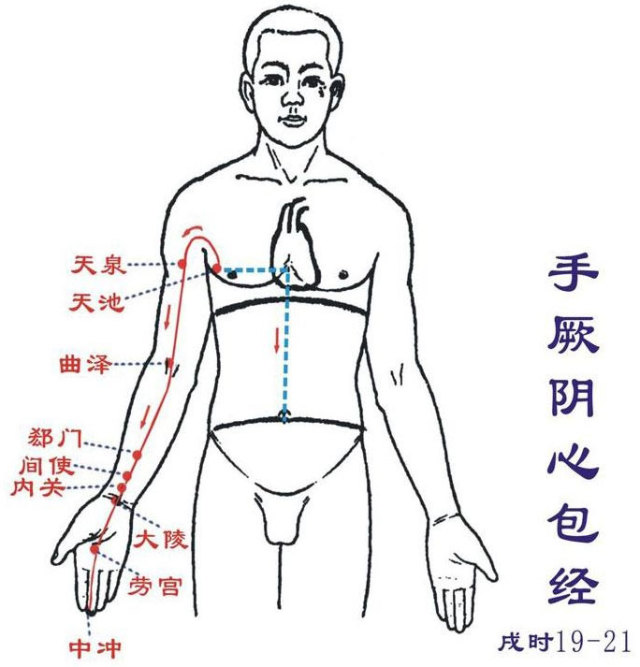
Jueyin Pericardium Meridian (Shǒu Juéyīn Xīnbāo Jīng) (Hour of the Dog: 7-9 PM): From the chest to the hand
The Pericardium Meridian passes through three important points that separate the chest and abdomen: Tiānzhōng, Zhōngwǎn, and Yīnjiāo. It runs through the chest, lateral abdomen, inner side of the hand, palm, and middle finger continuously. Starting from the chest, it emerges belonging to the Pericardium, passes through the diaphragm, traverses the chest, upper abdomen, and lower abdomen, connecting to the Sanjiao.
Its branch: along the chest, exits at the side, at the three cun below the armpit (Tiānpí), ascends to the armpit, along the inner side of the upper arm (Tiānquán), between the Hand Taiyin and Hand Shaoyin, enters the elbow (Qūzé), descends along the forearm, runs between the two tendons (the radial side of the wrist flexor tendon and the palmaris longus tendon) (Xièmén, Jiànshǐ, Nèiguān, Dàlǐng), enters the palm (Láogōng), exits at the tip of the middle finger (Zhōngchōng).
Its branch: from the palm, runs along the ring finger to the tip, connecting to the Hand Shaoyang Sanjiao Meridian.
This meridian has 9 points on one side (18 points total), with 8 points distributed on the palm surface of the upper limb, and 1 point in the upper part of the chest. Starting point Tiānzhōng, endpoint Zhōngchōng.
Indications include conditions of the heart, chest, stomach, mental disorders, and other conditions in areas traversed by this meridian, such as heart pain, chest tightness, palpitations, irritability, mania, axillary swelling, and elbow spasms.
● Points of this meridian: Tiānzhōng, Tiānquán, Qūzé, Xièmén, Jiànshǐ, Nèiguān, Dàlǐng, Láogōng, Zhōngchōng.
● Source point: Dàlǐng (with the palm facing up, above the wrist crease, between the radial side of the wrist flexor tendon and the palmaris longus tendon)
● Luo point: Nèiguān (on the palm side of the forearm, 2 cun above the wrist crease)
● Transport point: Dàlǐng (with the palm facing up, above the wrist crease, between the radial side of the wrist flexor tendon and the palmaris longus tendon)
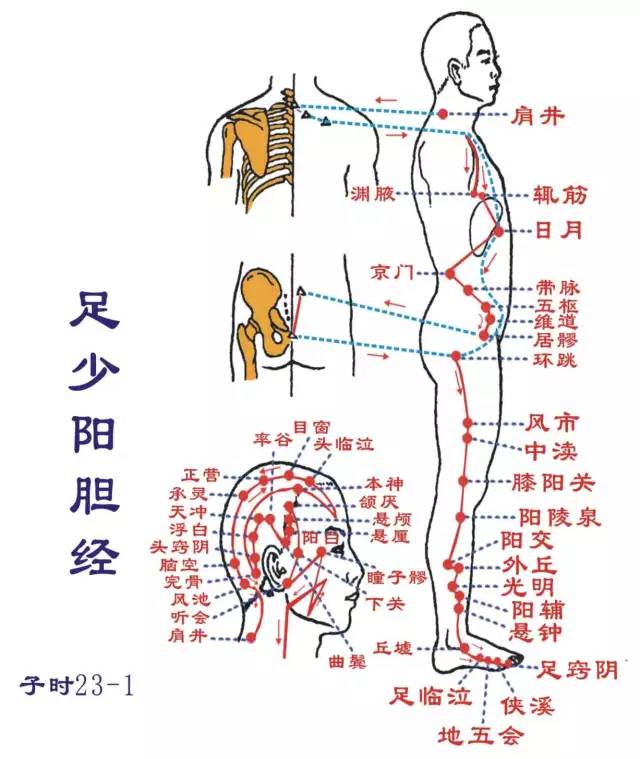
Shaoyang Sanjiao Meridian (Shǒu Shàoyáng Sān Jiāo Jīng) (Hour of the Pig: 9-11 PM): From the hand to the head
Starts at the tip of the ring finger (Guānchōng), ascends between the little and ring fingers (Yèmén), along the back of the hand (Zhōngzhǔ, Yángchí), exits between the two bones of the forearm (the ulna and radius) (Wàiguān, Zhīgōu, Huìzōng, Sānyángluò, Sìdù), ascends through the elbow (Tiānjǐng), along the outer side of the upper arm (Qīnglěngyuān, Xiāoluò), ascends through the shoulder (Nàohuì, Jiānliáo), meets at the back of the neck (Tiānjiāo; Huìbǐngfēng, Jiānzhōng, Dàzhuī), enters the supraclavicular fossa, distributes in the Tiānzhōng (mediastinum), disperses in the Pericardium, passes through the diaphragm, widely belonging to the upper, middle, and lower Sanjiao.
Its branch: ascends from the Tiānzhōng, exits the supraclavicular fossa, ascends to the back of the neck, connects to the ear (Tiānyǒu, Yìfēng, Lúxī), directly ascends to the top of the ear (Jiǎosūn; Huìhèliáo, Xuánlì, Shàngguān), bends down to the cheek, to below the eye (Quánliáo).
Its branch: enters the ear, exits in front of the ear (Héliáo, Érmén; Huìtīnghuì), passes in front of the upper guān, connects to the cheek, to the outer corner of the eye (Sīzhú kōng; Huìtóngzǐliáo), connecting to the Foot Shaoyang Gallbladder Meridian. Additionally, the Sanjiao connects with the Yangming Bladder Meridian at the Wěiyáng point.
This meridian has 23 points on one side (46 points total), with 13 points distributed on the dorsal surface of the upper limb, and 10 points in the neck and lateral head. Starting point Guānchōng, endpoint Sīzhú kōng.
Indications include conditions of the chest, heart, lung, throat, certain febrile diseases, and conditions in areas traversed by this meridian.
● Points of this meridian: Guānchōng, Yèmén, Zhōngzhǔ, Yángchí, Wàiguān, Zhīgōu, Huìzōng, Sānyáng, Luò, Sìdù, Tiānjǐng, Qīnglěngyuān, Xiāoluò, Nàohuì, Jiānliáo, Tiānjiāo, Tiānyǒu, Yìfēng, Lúxī, Jiǎosūn, Érmén, Érhuòliáo, Sīzhú kōng.
● Source point: Yángchí (in the middle of the wrist crease)
● Luo point: Wàiguān (2 cun above the wrist crease)
● Transport point: Zhōngzhǔ (when making a fist, in the depression between the fourth and fifth metacarpal heads)

Gallbladder Meridian (Zú Shàoyáng Dǎn Jīng) (Hour of the Rat: 11 PM-1 AM): From the head to the foot
Starts at the outer corner of the eye (Tóngzǐliáo), ascends to the corner of the forehead (Huìyán, Xuánlì, Xuánlì, Qūchā; Huìtóuwéi, Huìhèliáo, Huìjiāosūn), descends behind the ear (Shuàigǔ, Tiānchōng, Fúbái, Tóuqiàoyīn, Wángǔ, Běnshén, Yángbái, Tóulínqì), along the neck, running along the Hand Shaoyang Sanjiao Meridian (Jīngtiānróng), to the shoulder, retreating, connecting to the Hand Shaoyang Sanjiao Meridian (Huìdàzhuī, Jīngjiān, Huìbǐngfēng), enters the supraclavicular fossa.
Its branch: enters the ear (Huìyìfēng), runs in front of the ear (Tīnghuì, Shàngguān; Huìtīnghuì, Xiàguān), to the outer corner of the eye;
Another branch: from the outer corner of the eye, descends to Dàyíng, connects to the Hand Shaoyang Sanjiao Meridian to below the eye; descends through the jaw (Xiàjiāo), descends along the neck, connecting to the supraclavicular fossa. From here, it descends to the chest, passes through the diaphragm, connects to the Liver, belongs to the Gallbladder; along the ribs, exits at the Qìjiē (inguinal artery area), encircles the pubic hair, horizontally enters the hip joint.
Its main trunk (direct pathway): from the supraclavicular fossa descends to the armpit (Yuánliè, Zhèngjīn; Huìtiānpí), along the side of the chest, passes through the ribs (Rìyuè, Jīngmén; Huìzhāngmén), descends to the hip joint (Dàimài, Wǔshū, Wéidào, Jūliáo… Huán tiāo). From here, it descends along the outer side of the thigh (Fēngshì, Zhōnglù), exits at the outer side of the knee (Xīyángguān), descends to the front of the fibula (Yánglíngquán), directly down to the lower part of the fibula (Yángjiāo, Wàiqiū, Guāngmíng, Yángfǔ, Xuánzhōng), exits in front of the lateral malleolus (Qiūxū), along the dorsum of the foot enters the outer side of the fourth toe (Zútōnggǔ, Dìwǔhuì, Xiáxī, Zúqiàoyīn).
Its branch: from the dorsum of the foot, enters the first toe’s interspace, along the first and second metatarsals, exits at the tip of the toe, returns through the nail, exits at the toe’s back, connecting to the Hand Jueyin Liver Meridian.
This meridian has 44 points on one side (88 points total), with 15 points distributed on the outer side of the lower limb, and 29 points in the hip, lateral chest, and lateral head. Starting point Tóngzǐliáo, endpoint Zúqiàoyīn.
Indications include conditions of the chest and ribs, liver and gallbladder disorders, febrile diseases, neurological disorders, and conditions in areas traversed by this meridian.
● Source point: Qiūxū (in front of the lateral malleolus)
● Luo point: Guāngmíng (on the outer side of the lower leg, 5 cun above the tip of the lateral malleolus, at the anterior edge of the fibula)
● Transport point: Zúqiàoyīn (on the outer side of the foot, behind the fourth toe joint)
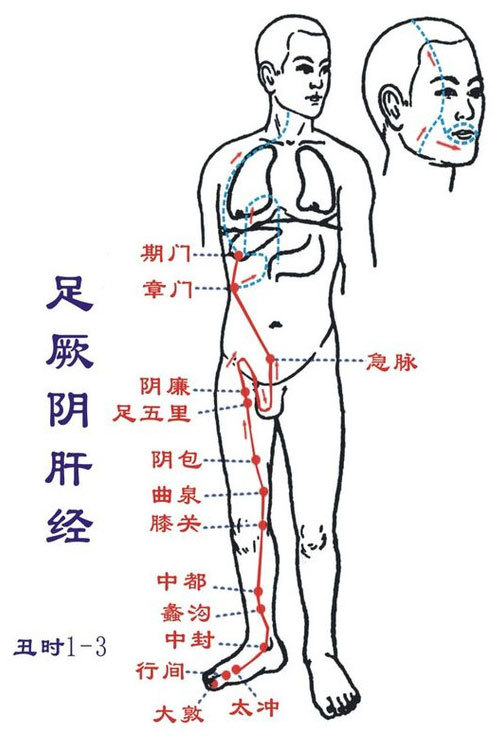
Jueyin Liver Meridian (Zú Juéyīn Gān Jīng) (Hour of the Ox: 1-3 AM): From the foot to the abdomen
Starts at the back of the big toe (Dàdū), ascends along the inner side of the foot (Xíngjiān, Tàichōng), 1 cun from the inner malleolus (Zhōngfēng), ascends along the inner side of the lower leg (Huì Sānyīnjiāo; passes through Lìgōu, Zhōngdū, Xīqū), 8 cun from the inner malleolus, connects to the inner side of the knee (Qūquán), along the inner side of the thigh (Yīnbāo, Zúwǔlǐ, Yīnlán), enters the pubic area, encircles the area, to the lower abdomen (Jímài; Huìchōngmén, Fùshè, Qūgǔ, Zhōngjí, Guānyuán), alongside the stomach, belongs to the Liver, connects to the Gallbladder (Zhāngmén, Qīmén); ascends through the diaphragm, distributes in the ribs, along the trachea, ascends to the forehead, connecting to the governing vessel at the top of the head.
Its branch: from the “eye system” descends to the cheek, encircling the lips.
Its branch: from the Liver, ascends through the diaphragm, flows into the Lung (connecting to the Hand Taiyin Lung Meridian).
This meridian has 14 points on one side (28 points total), with 12 points distributed on the inner side of the lower limb, and 2 points in the abdomen and chest. Starting point Dàdū, endpoint Qīmén.
Indications include urinary and reproductive system disorders, neurological disorders, liver and gallbladder disorders, eye diseases, and conditions in areas traversed by this meridian.
● Points of this meridian: Dàdū, Xíngjiān, Tàichōng, Zhōngfēng, Lìgōu, Zhōngdū, Xīqū, Qūquán, Yīnbāo, Zúwǔlǐ, Yīnlán, Jímài, Zhāngmén, Qīmén.
● Source point: Tàichōng (on the dorsum of the foot, at the depression behind the first metatarsal)
● Luo point: Lìgōu (on the inner side of the lower leg, 5 cun above the tip of the inner malleolus, at the center of the tibia)
● Transport point: Tàichōng (on the dorsum of the foot, at the depression behind the first metatarsal)
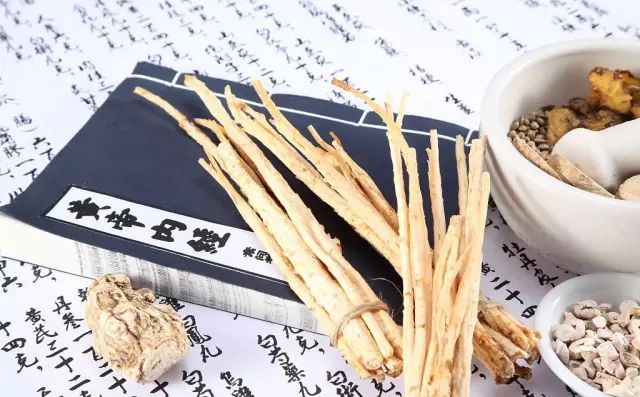
Summary Table for Remembering the Locations of Source, Luo, and Transport Points
Lung Meridian
Source and Transport Point: Tàiyuán: at the radial side of the wrist crease, in the depression on the radial side of the radial artery
Luo Point: Lièxuè: 1.5 cun above the wrist crease, on the radial side of the forearm
Large Intestine Meridian
Source Point: Hégǔ: on the back of the hand, between the first and second metacarpals, at the midpoint of the radial side of the second metacarpal
Luo Point: Piānlì: on the back of the elbow, 3 cun above the wrist crease
Transport Point: Sānjiān: when making a fist, in the depression on the radial side of the second metacarpal head
Stomach Meridian
Source Point: Chōngyáng: on the dorsum of the foot, at the base of the second metatarsal and the intermediate cuneiform joint, can feel the dorsalis pedis artery
Luo Point: Fēnglóng: on the anterior lateral side of the lower leg, 8 cun above the tip of the lateral malleolus, at the horizontal finger distance from the anterior edge of the tibia
Transport Point: Xiànggǔ: in the depression behind the second and third metatarsophalangeal joints on the dorsum of the foot
Spleen Meridian
Source and Transport Point: Tàibái: behind the first metatarsal head, at the red-white junction
Luo Point: Gōngsūn: in front of the first metatarsal base
Heart Meridian
Source and Transport Point: Shénmén: at the radial side of the wrist crease
Luo Point: Tōnglǐ: on the palm side of the forearm, on the radial side, 1 cun above the wrist crease
Small Intestine Meridian
Source Point: Wàngǔ: on the palm side, at the radial side of the fifth metacarpal base
Luo Point: Zhīzhèng: on the back of the forearm, 5 cun above the wrist crease
Transport Point: Hòuxī: when making a fist, at the back of the fifth metacarpophalangeal joint
Bladder Meridian
Source Point: Jīnggǔ: on the outer side of the foot, below the fifth metatarsal tuberosity, at the red-white junction
Luo Point: Fēiyáng: on the posterior lateral side of the lower leg, 7 cun above the tip of the lateral malleolus
Transport Point: Shùgǔ: below the fifth metatarsal head, at the red-white junction
Kidney Meridian
Source and Transport Point: Tàixī: in the depression between the inner malleolus and the Achilles tendon, at the level of the highest point of the inner malleolus
Luo Point: Dàzhōng: on the inner side of the foot, below the Achilles tendon attachment
Pericardium Meridian
Source and Transport Point: Dàlǐng: with the palm facing up, above the wrist crease, between the radial side of the wrist flexor tendon and the palmaris longus tendon
Luo Point: Nèiguān: on the palm side of the forearm, 2 cun above the wrist crease
Sanjiao Meridian
Source Point: Yángchí: in the middle of the wrist crease
Luo Point: Wàiguān: 2 cun above the wrist crease
Transport Point: Zhōngzhǔ: when making a fist, in the depression between the fourth and fifth metacarpal heads
Gallbladder Meridian
Source Point: Qiūxū: in front of the lateral malleolus
Luo Point: Guāngmíng: on the outer side of the lower leg, 5 cun above the tip of the lateral malleolus, at the anterior edge of the fibula
Transport Point: Zúqiàoyīn: on the outer side of the foot, behind the fourth toe joint
Liver Meridian
Source and Transport Point: Tàichōng: on the dorsum of the foot, at the depression behind the first metatarsal
Luo Point: Lìgōu: on the inner side of the lower leg, 5 cun above the tip of the inner malleolus, at the center of the tibia

